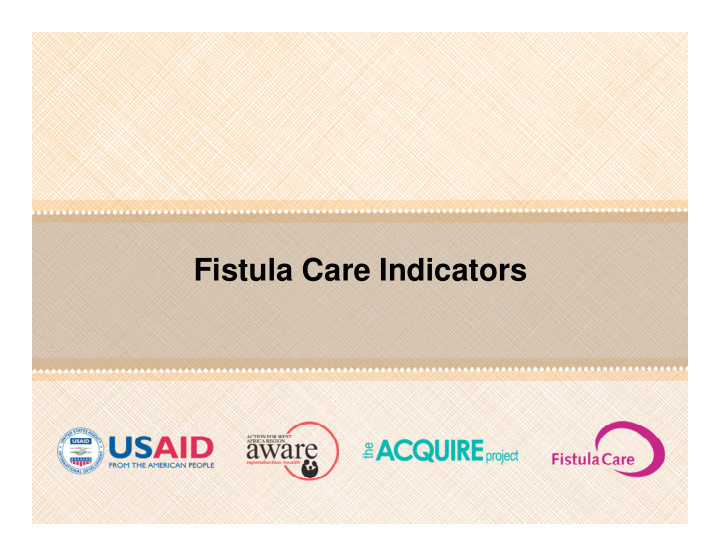



Fistula Care Indicators
Figure 1: FC Results Framework To establish and/or strengthen fistula prevention, repair, and STRATEGIC reintegration programs in at least 12 institutions in sub -Saharan Africa OBJECTIVE and south Asia IR 1: Strengthen the capacity IR 2: Enhance community and IR 3: Gather, analyze, and IR 4: Strengthen a supportive of centers to provide quality facility understanding and report data to improve the environment to institutionalize services to repair and care for practices to prevent fistula, quality of performance of fistula prevention, repair and women with fistula utilize and deliver services fistula services reintegration of services IR 1.1: Fistula centers IR 2.1: Facilities monitoring IR 3.1: Program activities IR 4.1 Strengthen policies in supported to provide fistula labor and providing timely monitored and outcomes countries to improve access repair and care emergency response for evaluated to and quality of fistula prolonged/obstructed labor services IR 1.2: High quality clinical IR 2.2: Facilities linked with IR 3.2: Research designed IR 4.2 Global leadership fistula repair and care community agents and and implemented demonstrated through implemented at the sites organizations sharing information and materials IR 1.3: Increased capacity of IR 2.3: Fistula clients IR 3.3: Information facilities ’ personnel to received counseling and disseminated about lessons provide quality fistula repair support for reintegration learned and research and care into their communities findings IR 1.4: Models implemented IR 2.4: Collaboration with to improve quality and maternal health programs efficiency of fistula care and services
Strategic Objective : To establish and/or strengthen fistula programs in sub-Saharan Africa and south Asia • Number of sites providing fistula repairs with Fistula Care /USAID support • Number of women receiving fistula repair surgery
Result 1: Strengthen the capacity of centers to provide quality services for obstetric and traumatic gynecologic fistula • Number/percent of women who received fistula surgery who have a closed fistula and are dry upon discharge • Number /percent of women who had fistula surgery who experienced complications (disaggregated by type of complication) • Number of providers trained, by type of training and cadre
Result 2: Enhance understanding and practices to prevent fistula, including emergency obstetric care, and support women’s reintegration • Number of community outreach activities and number of persons reached about prevention of obstetric fistula • Number of FC supported sites provided with technical assistance to improve EoC services (e.g. c-section) • Number of clients served with FP services at FC-supported sites • Percent of births at FC supported facilities that are by c-section ** • Percent of pregnant women presenting at FC supported facility for which labor has lasted >24 hours (expect this to decrease over time)** ** Proposed
Result 3: Gather, analyze, and report data to improve the quality and performance of fistula services • Number/percent of supported sites with an established and functioning management information system used for improving fistula services • Number of evaluation and research studies conducted
Result 4: Strengthen a supportive environment to institutionalize fistula prevention, repair and reintegration programs • Number of countries where Fistula Care supported programs are supporting governments to develop policies related to fistula prevention and treatment • Number of technical products produced by Fistula Care for improving fistula care treatment and prevention services
FistulaTreatment Quarterly Monitoring Indicators 1. Number of women arriving and seeking fistula repair 2. Number of women requiring fistula repair surgery 3. Number of women receiving surgery for fistula repair (disaggregated by number of previous repairs: first repair, second repair, >2 repairs) 4. Number of women who were discharged after receiving fistula surgery 5. Number/percent of women who received fistula surgery who have a closed fistula and are dry at time of discharge from the facility
Fistula Treatment Quarterly Monitoring Indicators 6. Number of women who received fistula surgery who had a closed fistula with remaining stress incontinence at time of discharge from the facility 7. Number of women who received fistula surgery whose fistula was not closed at time of discharge from the facility 8. Number/percent of women who received fistula surgery and were discharged from the facility who experienced complications (disaggregated by type of complication) 9. Number of women who remain in post-op care and were not discharged this quarter
Recommend
More recommend